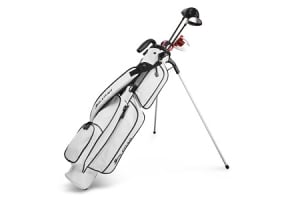
How Do I Increase My Swingweight?
The club feels too light in your hands, you cut the club shorter for more control, added a heavier grip, re-shafted with a lighter shaft or the swingweights were not a consistent in your set, these are all reasons why you might need to add weight to a golf club head. Here are some tips for properly adding weight to help balance your clubs and improve performance and confidence.
Experiment at the Range
If the swingweight of all your clubs are all over the place and you hit them well, is there any reason to change? Good question. You really won't know unless you try by adding weight first and hitting balls at the range or on the practice putting green to see if you can notice any improvement. If you don't hit the clubs as well as you think, there is even more of an argument to experiment with a few clubs. The best part is it requires very little equipment or time and if you find increasing head weight doesn't help, it is very easily remedied by simply removing the weight.
Your driver and especially wedges and your putter are specialty clubs which may require swingweights different from the remainder of the set. Perhaps you have a favorite club. If so, measure the club's swingweight against all other clubs and try to match the other like clubs (iron vs iron, hybrid vs hybrid, etc.). If you don't have access to a swingweight scale, you can use our Assembled Swingweight Calculator.
3 Common Weighting Options
The common means of adding weight to the head are weight screws, lead tape and rubber coated tungsten weights. Let's explain the pros and cons of each method.
Weight Screws
The option of changing the weight via a screw is dependent upon whether the head is equipped with a removable screw and if there are options for heavier screws. This might pertain more to a driver, putter perhaps some fairway woods and hybrids too. All you need is a wrench to remove the existing weight and add the heavier one, but you will be limited by what weights are available. Any other fine-tuning will require to use the next two items.

Lead Tape
Lead tape has been the most common method used for fine-tuning the weight of the head. You can see images of touring pro clubs with it layered over the back of their irons and wedges. A roll of lead tape usually is available in ½" width and is cut to lengths to fit the area of the club where you want to add it. The tape will have a strip of paper on one side. Once you remove the paper, it will expose the sticky side of the tape. The lead foil tape is thin and may require layering over one another while pressing down to secure it in place. Depending upon the density or thickness of the tape, it may require as much as a 4" strip to add 2 grams. It may not be pretty when you get down, but it is effective. The downside is you are working with lead so use precautions like wearing gloves, proper disposal and washing your hands thoroughly afterwards.

Rubber Coated Tungsten Weights
An alternative to lead tape is rubber coated tungsten weights such as FlexWeight. These will be in a small sheet of self-adhesive squares that can be cut and placed onto the clubhead. Tungsten is much denser than lead, so it requires much less space to increase the weight. The rubber coated tungsten weights are much safer than lead and look much cleaner on the club. Unlike the lead tape, you do not want to overlap the weights onto themselves; only apply single layer. In the following image is the same amount of weight added (7 grams) as the lead tape shown.

Clubhead Preparation
Using isopropyl alcohol on a clean cloth or rag, wipe the area of the head you will add the lead tape or rubber coated tungsten weights and allow for it to thoroughly dry before applying weight. This will ensure that the adhesive backing will adhere properly to the clubhead's surface.
Application
When adding the lead tape or rubber coated tungsten weights, pick a smooth surface rather than one with a lot of engravings, cut-outs, or ridges. Avoid putting any weight on the sole of the club that will wear off when contacting the ground and obviously the face of the club. Remember to press down on the weights for a few seconds.
Adding 2 grams of weight is approximately equivalent to 1 swingweight. For longer clubs like a driver, it is closer to 1.6 grams, that is why it is an approximate. Theoretically, applying weight to the toe will cause fade spin, to the heel will create draw spin, low and/or rearward will launch the ball higher and high and/or forward will lower the trajectory. However, it must be a rather significant amount of weight for you to notice any change. A few grams won't turn your slice into a straight shot. However, if you have a slight pull, adding weight can certainly help to get you on the straight and narrow. Adding weight is more for consistency and feel which in the end can improve confidence.
If you ever need to remove the weight for any reason, it is totally reversable. It may require a small knife blade to pry the weight safely from the head and then you can use the isopropyl alcohol or solvent to clean off the sticky residue.
Related Articles:
A Real Game Changer for Clubmakers – Tour Lock Pro Counterweights
Head Weights, Shaft Weights and Balance Points – Oh My!





